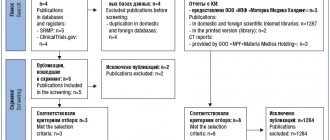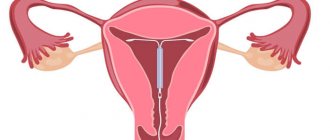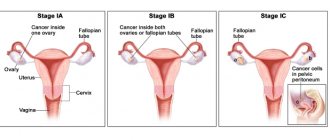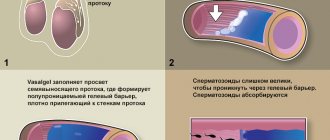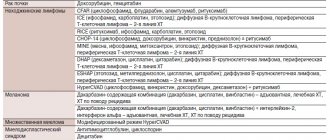Let's dwell on physiological methods of contraception . They do not involve the use of medications, various devices and manipulations. Knowing the characteristics of her body, a woman can plan her intimate life in such a way as to protect herself from unwanted pregnancy. Who are these methods indicated for and how effective are they? Physiological or biological methods of contraception are natural methods of family planning. Consists of abstaining from sexual intercourse during the fertile phase of the menstrual cycle (the period during which a woman can become pregnant). During the menstrual cycle, a woman’s body prepares for conception and pregnancy. If conception does not occur, this process is repeated again. The duration of the menstrual cycle is determined from the first day of menstruation (the beginning of bleeding) to the first day of the next and is 21-36 days, more often - 28 days.
Methods of protection against unplanned pregnancy
The content of the article
All methods of contraception are divided into natural and artificial.
Artificial ones include:
- hormonal contraception,
- barrier methods,
- uterine devices,
- chemical contraceptives,
- surgical sterilization.
Natural methods to protect against unwanted pregnancy include:
- measuring body temperature,
- monitoring of discharge;
- calendar observation of monthly rhythms,
- method of interrupting sexual intercourse,
- symptothermal method.
The effectiveness of each specific method is assessed according to the number of pregnancies per 100 women who use one or another contraception for 12 months. From this point of view, all methods of preventing unwanted pregnancy can be divided into three groups:
- Very effective measures
, when the number of pregnancies per 100 women does not exceed 1%, include hormonal implants, surgical sterilization, uterine devices, injectable progestins; - Effective measures
ensure only 2-9% of pregnancies per 100 women. This is hormonal contraception, lactational amenorrhea (first 6 months); - Moderately effective measures
with a risk of pregnancy of 10-30%. These are the barrier method, pharmaceutical preparations for topical use, natural planning methods.
Sources
- Du X., Liu J., Xue Y., Kong X., Lv C., Li Z., Huang Y., Wang B. Alteration of gut microbial profile in patients with diabetic nephropathy. // Endocrine - 2021 - Vol - NNULL - p.; PMID:33905112
- Zhou X., Liu X., Liu H., Dou S., Chen K., Zhang X., Wang W., Wang X., Che J. CD36+/CD61+ Microparticles Correlate with the Risk of Percutaneous Cardiac Interventions in Coronary Artery Disease Patients and the Effects of Ticagrelor. // Cardiovasc Drugs Ther - 2021 - Vol - NNULL - p.; PMID:33893936
- Smiley CL., Rebeiro PF., Cesar C., Belaunzaran-Zamudio PF., Crabtree-Ramirez B., Padgett D., Gotuzzo E., Cortes CP., Pape J., Veloso VG., McGowan CC., Castilho JL . Estimated life expectancy gains with antiretroviral therapy among adults with HIV in Latin America and the Caribbean: a multisite retrospective cohort study. // Lancet HIV - 2021 - Vol - NNULL - p.; PMID:33891877
- Sun N., Meng X., Liu Y., Song D., Jiang C., Cai J. Applications of brain organoids in neurodevelopment and neurological diseases. // J Biomed Sci - 2021 - Vol28 - N1 - p.30; PMID:33888112
- Chen Y., Li H., Yang J., Zheng H., Guo L., Li W., Yang Z., Song J., Liu L. A hSCARB2-transgenic mouse model for Coxsackievirus A16 pathogenesis. // Virol J - 2021 - Vol18 - N1 - p.84; PMID:33882964
- Zheng X., Kuang J., Lu C., Deng Q., Wu H., Murithi RG., Johnson MB., Peng W., Wu M. Preconceptional and prenatal exposure to diurnal temperature variation increases the risk of childhood pneumonia. // BMC Pediatr - 2021 - Vol21 - N1 - p.192; PMID:33882898
- Liu Z., Wang R., Zhou J., Zheng Y., Dong Y., Luo T., Wang X., Zhan W. Ultrasound lymphatic imaging for the diagnosis of metastatic central lymph nodes in papillary thyroid cancer. // Eur Radiol - 2021 - Vol - NNULL - p.; PMID:33881571
- McCann-Pineo M., Taioli E., Schwartz RM. Exposure to Hurricane Sandy and Risk of Opioid Abuse. // Subst Use Misuse - 2021 - Vol - NNULL - p.1-5; PMID:33870867
- Du HJ., Zhao SX., Zhao W., Fu N., Li WC., Qin XJ., Zhang YG., Nan YM., Zhao JM. Hepatic Macrophage activation and the LPS pathway in patients with different degrees of severity and histopathological patterns of drug induced liver injury. // Histol Histopathol - 2021 - Vol - NNULL - p.18340; PMID:33870482
- Wang J., Qian R., Wang Y., Dong M., Liu X., Zhou H., Ye Y., Chen G., Chen D., Yuan L., Xiao J., He G., Hu J ., Zeng W., Rong Z., Zhang Q., Zhou M., Jin J., Fan J., Sun J., Ma W., Zhang B., Liu T. The mediation effect of placental weight change in the association between prenatal exposure to selenium and birth weight: Evidence from a prospective birth cohort study in China. // Environ Epidemiol - 2021 - Vol5 - N2 - p.e139; PMID:33870013
Pros and cons of natural contraception
Contraception is not perfect. A woman should know about the effectiveness of various methods of preventing unwanted pregnancy, their strengths and weaknesses. In each specific case, she should consult with a gynecologist about choosing the most appropriate method of contraception, which is selected taking into account the woman’s age, health status, and characteristics of her sexual life. Natural methods of contraception are based on determining the fertile days of the menstrual cycle. During these days, it is recommended to avoid unprotected sexual intercourse.
Benefits of natural contraceptive methods:
- No side effects;
- Do not contradict religious beliefs;
- Does not require spending money;
- Distribution of responsibility among both partners;
- Harmless, can be used endlessly.
Disadvantages of natural contraception:
- Moderately effective measures that do not provide a 100% guarantee;
- It is not always possible to accurately determine the time of ovulation;
- Forced periodic abstinence;
- The risk of getting sexually transmitted infections increases.
Important!
When choosing a method of non-hormonal contraception, be sure to consult your doctor, since the use of chemicals such as spermicides may cause allergic reactions.
Illustration: Juan Pablo Colasso Tags:
- Pregnancy
- Sex
- Contraception
1 comment • To leave a comment you must be an authorized user
- Fiztashka Regarding abstinence, a couple of years ago there was a story on LiveJournal about how Orthodox spouses abstained for some reason, the husband apparently resolved his bodily burden in the bathtub, which he did not wash well after this, and the girl (according to her) thus became pregnant. So only nunneries, it turns out)
Types of natural contraception and methods of use
Calendar or rhythmic method.
Suitable for persons with regular menstrual cycles. To determine fertile days for a particular woman, she must observe the periods of the menstrual cycle for 12 months (or at least 6).
Most often, ovulation, in other words the release of an egg, occurs on the 14th day of the cycle. The likely duration of favorable time is at least 2 days before and after ovulation. The beginning and end of the fertile period are calculated using the following formula. From the total number of days of the shortest cycle over the past year, you need to subtract 18 (20), and from the total number of days of the longest cycle in the past year, you need to subtract 10 (or 11).
Let's say that over the last 12 months the menstrual cycle repeats every 26-29 days, which means that from the 6th to the 19th day of the cycle we have days favorable for conception. Couples should avoid intimacy during this period, or use barrier contraception. Basal temperature method.
is based on an increase in body temperature (0.2-0.4 ° C) after ovulation until the end of the cycle due to the influence of progesterone in the corpus luteum of the ovary. Thus, ovulatory cycles are characterized by biphasic body temperature. Unfavorable days for conception begin on the third day after the temperature rises.
This method requires measuring body temperature daily and displaying the data in a table. It is necessary to measure the temperature in the same place (armpit, mouth or anus) every day when you wake up using a convenient thermometer.
Measurements must be taken every month. It is known that external factors: stress, illness, alcohol, medications, etc., affect fluctuations in body temperature, causing errors in the method. Cervical mucus method (Billing)
. Cervical mucus changes during the menstrual cycle due to the effects of hormones. To determine ovulation and fertile days, the nature of mucous secretions is assessed. This method of contraception is not suitable if you have an infection in the vagina or cervix, or during breastfeeding. Nature of mucus:
- The first stage is before ovulation. The genital area is dry, there is no mucus or traces of discharge on the underwear. These days are barren.
- The second stage is the fertile phase. The discharge is more transparent, moist, viscous, and there is more and more of it. On your most fertile day, the type of mucus mimics raw egg white. The days suitable for fertilization are the time of heavy mucus discharge before the peak (its maximum amount) and the first 3 days after the peak.
- The third stage is after ovulation, there is no mucous discharge, there is “dryness” or a small amount of white, sticky mucus. Barren days begin on the fourth day after the peak of discharge.
Symptothermic
The pathway is a combination of several natural defenses used to determine the first and last days of the fertile period.
The first favorable day of the cycle can be determined by assessing cervical mucus. The last day of the menstrual cycle suitable for conception is determined by calendar, basal body temperature or changes in the cervical mucosa. Withdrawing sexual intercourse
is an ineffective method because a certain number of men release a small amount of sperm before orgasm. The possibility of fertilization remains even when the sperm is localized on the external genitalia. This method is not suitable for men suffering from premature ejaculation. It requires a good partner's potency.
Lactation (postpartum) amenorrhea
. During lactation, the process of ovulation is absent as well as menstruation due to the effect of the corresponding hormones. The World Health Organization (WHO) recommends that women who are continuously breastfeeding after childbirth should use reliable contraception within 3 months of the baby's birth. If a woman does not fully breastfeed, it is necessary to start using contraception 3 weeks after pregnancy is resolved.
Coitus interruptus
The essence of the method lies in its name. Immediately before ejaculation, the man removes the penis from the woman’s vagina so that ejaculation occurs “from the outside.” Experts consider this method unreliable and psychologically uncomfortable for both partners. The Pearl index is 14-18
.
Myths about contraception
Some people mistakenly believe that condoms are unreliable because they constantly break. However, only one to eight percent of condoms break, most often when used incorrectly. These and other misconceptions are in the material “Myths about contraception”: part one and part two.
What gynecologists say
Of course, gynecologists are against natural contraception. And this is understandable: after all, they are the ones who have to terminate unplanned pregnancies.
The unreliability of natural methods is associated with the characteristics of each woman’s body; the cycle can go wrong even due to mild stress or taking common medications for fever. It will not be possible to quickly trace the problem, so the likelihood of calculation errors increases.
And is there any point in taking such risks when there are many reliable methods of protection. Moreover, many of them are also used for medicinal purposes - normalization of the cycle, hormonal levels, regulation of the volume of menstrual discharge, additional protection against infections. The variety of modern contraceptive drugs allows you to choose a method for a woman of any age, health and with any frequency of sexual activity.
For example, women who are breastfeeding can use a uterine device, which is inserted 6 weeks after giving birth. Progestin-only tablets are also suitable for breastfeeding as they do not have any effect on the composition of the mother's milk.
Progestin is a very gentle drug that does not interfere with lactation and ovulation, and does not disrupt a woman’s menstrual cycle. It only changes the consistency of cervical mucus to very thick, making it an obstacle for sperm. The mucous membrane in the uterus also undergoes changes, causing the inability of the embryo to attach.
For young girls, special mini-pill tablets are suitable. And for women before menopause, a gynecologist-endocrinologist selects pills based on the results of hormone tests.
Gynecologists at the Diana Medical Clinic will select the most suitable method of contraception for you and provide detailed advice on how to use it.
If you find an error, please select a piece of text and press Ctrl+Enter
Sterilization
Surgical sterilization as a method of contraception is suitable for both men and women. Representatives of the fairer sex have their fallopian tubes tied, which prevents the egg from getting there. For men, the vas deferens is cut to prevent sperm from entering the ejaculate. The contraceptive effect of such contraception is very high, the Pearl index is 0-0.2. Pregnancy in rare cases occurs when the patency of the tubes is restored on its own. The sterilization method is irreversible, so you need to carefully weigh the pros and cons. After all, after this, people can no longer have children. Restoring tubal patency is very difficult, and a positive result is rarely achieved. Conceiving a child in such a situation is possible only with the help of IVF.
Sterilization is carried out for patients of any age in case of severe somatic illness (in women) or genetic pathology. Otherwise, the technique can be used only after 35 years, if there are two or more children.
The operation is performed by laparoscopy and lasts a little more than a quarter of an hour. Tubal ligation is sometimes done during a cesarean section or other abdominal surgery. But they must first obtain written consent from the patient.


